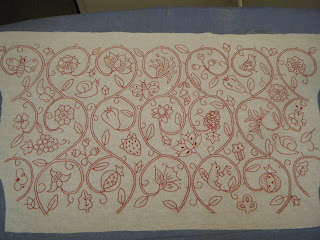Today's post is about a monochrome Elizabethan coif I made in 2010. The main inspiration for the piece came from the following extant linen, silk and metal thread example shown in Janet Arnold's 'Patterns of Fashion 4' (below).
I used the same sort of scrolling stem design, but added different motifs. I pored over Patterns of Fashion, Queen Elizabeth's Wardrobe Unlocked, and all my reproduction sixteenth century pattern books with Elizabethan-style motifs, and picked a variety of motifs that I thought went well together. I kept a reference as I drew up the pattern so that I would have a record of where the motifs were sourced from.
I traced the design out in water soluble ink. For this project, I remembered to keep a record of how long the stitching took. The picture above shows approximately fifty hours of stitching (not including pattern design, tracing out etc.)
The stitching was done predominantly in double running stitch because I need practice in that stitch.
 |
When the embroidery was done, I washed the coif in a gentle wool wash, rinsed, and gently blocked the fabric on a clean towel.
|
 |
| Here is the piece ready for metallic threads and spangling |
 |
| The back of the piece showing knotted and woven threads |
As you can see, I knotted AND wove the thread ends in on the back of the piece. I was not sure how the recipient would choose to launder the coif, and I wanted it to be durable.
 |
| There are small areas of other stitches, such as seeding, speckling, satin, stem and running stitch. |
.JPG) |
| The piece after metal spangles were added |
The images below are scanned from 'Patterns of Fashion 4' and show extant sixteenth and early seventeenth century English coifs.
.jpg) |
| The centre top seam is sewn and then gathered for about a third of the distance to allow for a bun or hair taping |
.jpg) |
| This picture shows the gathering stitches at the crown of one of the coifs |
.jpg) |
| This image shows tapes tying the coif in place in front of the bun or hair taping |
I will post more pictures of the finished article next time!
.jpg)





No comments:
Post a Comment